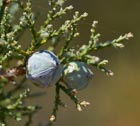
A stand in habitat, near Hill River, Western Australia (all photos same area) [©Rick Fencl, 2017.10.30].

Mature plants in habitat [©Rick Fencl, 2017.10.30].

Leader of a plant, showing new foliage and maturing seed cones [©Rick Fencl, 2017.10.30].

Foliage and mature seed cone [©Rick Fencl, 2017.10.30].

Older foliage and mature serotinous cones [©Rick Fencl, 2017.10.30].

Conservation Status

Callitris arenaria
(C.A. Gardner) E. Piggin & J.J. Bruhl 2010
Common names
Tamin or Bruce cypress-pine (Silba 1986).
Taxonomic notes
Many authorities still name this taxon Actinostrobus arenarius, for so it was known until (for me) 2020; see Callitris for discussion of why it is now placed in Callitris.
Syn: Actinostrobus arenarius Gardner 1964, A. pyramidalis var. arenarius (C.A. Gardner) Silba 1984. Type: near Tammin, Western Australia, Nov-1920, C.A. Gardner 610; holo: PERTH (Hill 1998).
Description
Shrub or small tree to 5 m. tall. Branches spreading; branchlets short, nearly triangular in the cross-section. Juvenile leaves glaucous. Adult leaves in 3's, ovate, acute, spreading, loosely imbricate, scale-like, slightly keeled, to 12 mm long, glaucous or grey-green. Male cones cylindrical, 3-5 mm long, 1.5-2 mm diam, with 16-18 ovate or rounded scales narrowing in the center to a point. Female cones globular-conical, acute, 15-20 mm long, 15-20 mm diam., glaucous when young; scales 6, acute, erect, slightly spreading when open, not apically hooked. Seeds tan or yellowish-brown, 6-11 mm. long, 2-3 winged, wings 1-2 mm. wide, hilium 2 mm. long. Cotyledons 2, rarely 3, blue-green, 9-14 mm. long by 1.5-2 mm. wide, stem thin, apex oval and bluntly acute (Silba 1986, Hill 1998).
Distribution and Ecology
Western Australia: "Endemic and locally abundant in sandy soil or sandplain, from around Shark Bay south to the Wongan Hills district, south-western WA." Cited collections (presumably wild plants) include: 14.4 km E of Hiscox-Kialoch road on Marchagee road; 1 mile N of Watheroo; 44 miles S of Wannoo; and Kalbarri road near turnoff to Murchison Gorge (Hill 1998). You can also create a highly detailed map, and access specimen data, using the "search" function at the Australia Virtual Herbarium.
Zone 10 (cold hardiness limit between -1°C and +4.4°C) (Bannister and Neuner 2001).
Remarkable Specimens
No data as of 2023.03.03.
Ethnobotany
Observations
Remarks
The epithet is from the Latin arenarius, meaning "sand", in reference to its usual soils.
Citations
Gardner, C.A. 1964. Contributiones Florae Australiae Occidentalis XIII. Cupressaceae. Journal of the Royal Society of Western Australia 47: 54.
Piggin, J., and J.J. Bruhl. 2010. Phylogeny reconstruction of Callitris Vent. (Cupressaceae) and its allies leads to inclusion of Actinostrobus within Callitris. Australian Systematic Botany 23:69-93.
See also
Blackall, W.E. and B.J. Grieve. 1954. How to Know W. Austral. Wildflowers. 1: 6, as A. p. vammophila (Illustrations).
Farjon (2005) provides a detailed account, with illustrations (as Actinostrobus arenarius).
Krussmann, G. 1985. Manual of Cultivated Conifers 2nd edition, 47, fig. 15 (Illustration).





